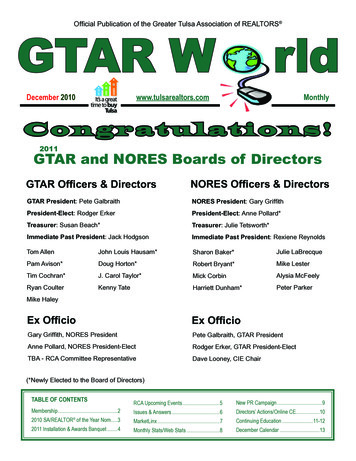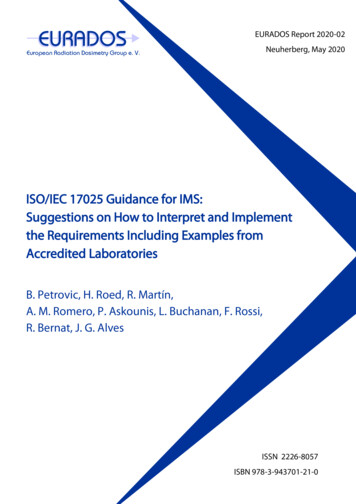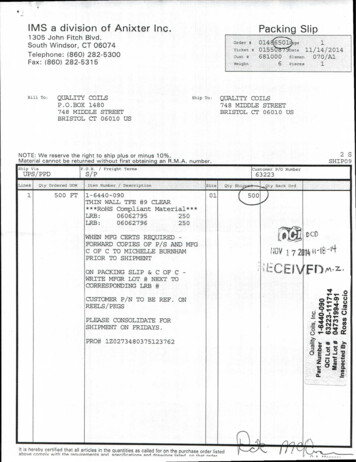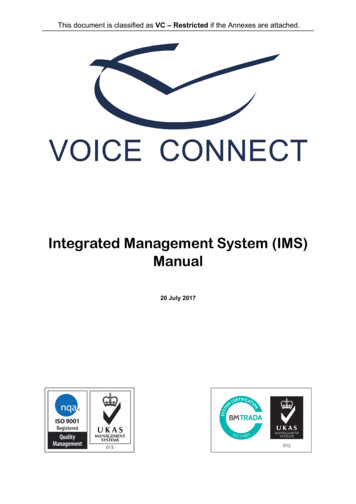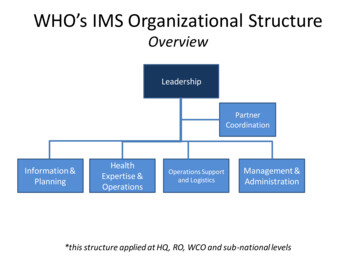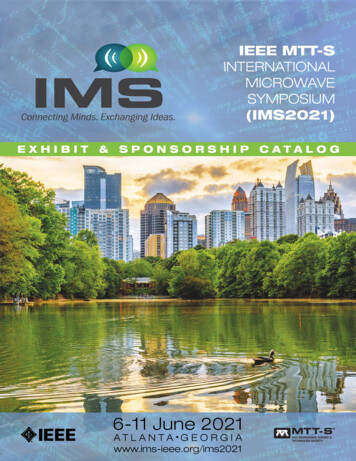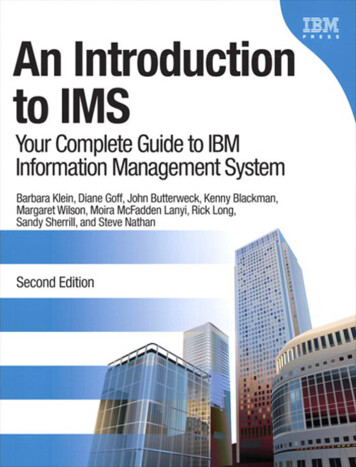
Transcription
An Introductionto IMSSecond Edition
An Introductionto IMSYour Complete Guide to IBMInformation Management SystemSecond EditionBarbara Klein, Diane Goff,John Butterweck, Kenny Blackman,Margaret Wilson, Moira McFaddenLanyi, Rick Long, Sandy Sherrill,Steve Nathan
The authors and publisher have taken care in the preparation of this book, but make no expressed or implied warranty of any kind and assume no responsibility for errors or omissions. No liability is assumedfor incidental or consequential damages in connection with or arising out of the use of the information orprograms contained herein. Copyright 2011 by International Business Machines Corporation. All rights reserved.Note to U.S. Government Users: Documentation related to restricted right. Use, duplication, or disclosureis subject to restrictions set forth in GSA ADP Schedule Contract with IBM Corporation.IBM Press Program Managers: Steve Stansel and Ellice UfferIBM Press Consulting Editor: Susan VisserCover design: IBM CorporationPublished by Pearson plcPublishing as IBM PressLibrary of Congress Cataloging-in-Publication Data:An introduction to IMS : your complete guide to IBM's Information Management System / Barbara Klein. [et al.]. -- [2nd ed.].p. cm.ISBN 978-0-13-288687-1 (pbk. : alk. paper)1. Management information systems. I. Klein, Barbara, 1947T58.6.I598 2012658.4'038011--dc232011036854IBM Press offers excellent discounts on this book when ordered in quantity for bulk purchases or specialsales, which may include electronic versions and/or custom covers and content particular to your business,training goals, marketing focus, and branding interests. For more information, please contact:U. S. Corporate and Government .For sales outside the U.S., please contact:International Salesinternational@pearsoned.com.
The following terms are trademarks or registered trademarks of International Business Machines Corporation in the United States, other countries, or both: IBM, the IBM Press logo, IMS, z/OS, WebSphere, Rational, System z, zSeries, CICS, DB2, Redbooks, RACF, z/VSE, Distributed Relational DatabaseArchitecture, Cognos, VTAM, Parallel Sysplex, Tivoli, NetView, InfoSphere, OS/390, Guardium,DataStage, and OMEGAMON. A current list of IBM trademarks is available on the web at “copyright andtrademark information” as www.ibm.com/legal/copytrade.shtml.Linux is a registered trademark of Linus Torvalds in the United States, other countries, or both.Java and all Java-based trademarks and logos are trademarks or registered trademarks of Oracle and/or itsaffiliates.UNIX is a registered trademark of The Open Group in the United States and other countries.Windows and Microsoft are trademarks of Microsoft Corporation in the United States, other countries, orboth.Other company, product, or service names may be trademarks or service marks of others.All rights reserved. This publication is protected by copyright, and permission must be obtained from thepublisher prior to any prohibited reproduction, storage in a retrieval system, or transmission in any form orby any means, electronic, mechanical, photocopying, recording, or likewise. For information regardingpermissions, write to:Pearson Education, Inc.Rights and Contracts Department501 Boylston Street, Suite 900Boston, MA 02116Fax (617) 671-3447ISBN-13: 978-0-13-288687-1ISBN-10: 0-13-288687-1First printing, December 2011
ContentsAcknowledgmentsAbout the AuthorsPrefacePart I: Overview of IMSChapter 1IMS: Then and NowChapter 2Overview of the IMS ProductIMS Database ManagerIMS Transaction ManagerIMS System ServicesIMS DocumentationHardware and Software Requirements for IMSChapter 3Access to and from IMSIMS Managed Application Program AccessAccess to IMS from Other Application Runtime EnvironmentsAccess to and from IMS Using the IMS SOA Integration SuiteChapter 4IMS and z/OSHow IMS Relates to z/OSStructure of IMS SubsystemsRunning an IMS SystemRunning Multiple IMS SystemsHow IMS Uses z/OS ServicesChapter 5Setting Up and Running IMSInstalling IMSDefining an IMS SystemIMS StartupIMS LoggingIMS Utility Programs
IMS RecoveryIMS ShutdownPart II: IMS Database ManagerChapter 6Overview of the IMS Database ManagerFunctions of the IMS Database ManagerImplementation of IMS DatabasesStoring Data in IMS and DB2 UDB for z/OSStoring XML Data in IMSOpen Database ManagerChapter 7Overview of the IMS Hierarchical Database ModelIMS Hierarchical Database BasicsBasic Segment TypesSequence Fields and Access PathsChapter 8Implementing the IMS Hierarchical Database ModelSegments, Records, and PointersIMS Hierarchical Access MethodsOperating System Access MethodsIMS CheckpointsLocking DataChapter 9Data SharingHow Applications Share DataDBRC and Data SharingChapter 10 The Database Reorganization ProcessPurpose of Database ReorganizationWhen to Reorganize DatabasesOverview of the Database Reorganization ProcessChapter 11 The Database Recovery ProcessDetermining When Recovery Is NeededOverview of the Database Recovery ProcessIMS Backup and Recovery UtilitiesPart III: IMS Transaction ManagerChapter 12 Overview of the IMS Transaction ManagerIMS TM Control RegionIMS TM MessagesIMS Transaction Flow
IMS TM Network OverviewThe Data Communication Control EnvironmentOperating an IMS NetworkChapter 13 How IMS TM Processes InputInput Message TypesTerminal TypesInput Message OriginTerminal Input DestinationMessage QueuingMessage SchedulingTransaction SchedulingPart IV: IMS Application DevelopmentChapter 14 Application Programming OverviewJava ProgramsApplication Program StructureIMS Setup for ApplicationsIMS Application Programming InterfacesIMS Application CallsAccessing DB2 for z/OS Using a Resource Translation TableIMS System Service CallsTesting IMS ApplicationsChapter 15 Application Programming for the IMS Database ManagerIntroduction to Database ProcessingProcessing a Single Database RecordCOBOL and PL/I Programming ConsiderationsProcessing Databases with Logical RelationshipsProcessing Databases with Secondary IndexesLoading DatabasesUsing Batch Checkpoint/RestartChapter 16 Application Programming for the IMS Transaction ManagerApplication Program ProcessingTransaction Manager Application DesignChapter 17 Editing and Formatting MessagesMessage Format ServiceBasic Edit FunctionChapter 18 Application Programming in JavaDescribing an IMS Database to the IMS Java Function
Supported SQL KeywordsDeveloping JMP ApplicationsDeveloping JBP ApplicationsEnterprise COBOL Interoperability with JMP and JBP ApplicationsAccessing DB2 UDB for z/OS Databases from JMP or JBP ApplicationsDeveloping Java Applications That Run Outside of IMSXML Storage in IMS DatabasesPart V: IMS System AdministrationChapter 19 The IMS System Definition ProcessOverview of the IMS System Definition ProcessIMS System Definition MacrosThe Extended Terminal OptionChapter 20 Customizing IMSWhat You Can CustomizeNaming the RoutinesChangeable Interfaces and Control BlocksIMS Standard User Exit Parameter ListBinding the RoutinesSaving RegistersIMS Callable ServicesConsidering PerformanceSummary of IMS Exit RoutinesChapter 21 IMS SecurityHistory of IMS SecuritySecurity OverviewSecuring ResourcesChapter 22 IMS LoggingIMS System CheckpointsDatabase Recovery Control FacilityIMS Log ComponentsChapter 23 Database Recovery Control FacilityOverview of DBRCDBRC TasksDBRC ComponentsWhen Should You Use DBRC?Communicating with DBRCDBRC FunctionsOverview of the RECON Data Sets
Defining and Creating the RECON Data SetsInitializing the RECON Data SetsAllocating the RECON Data Sets to an IMS SystemMaintaining the RECON Data SetsReorganizing RECON Data SetsRecreating the RECON Data SetsSummary of Recommendations for RECON Data SetsChapter 24 Operating IMSMonitoring the SystemProcessing IMS System Log InformationChoosing Tools for Detailed MonitoringExecuting Recovery-Related FunctionsModifying and Controlling System ResourcesControlling Data SharingControlling Log Data Set CharacteristicsConnecting and Disconnecting SubsystemsChapter 25 IMS System RecoveryOverview of Extended Recovery FacilityOverview of RemoteSite RecoveryComparison of XRF and RSRSummary of When to Use XRF or RSRChapter 26 IBM IMS ToolsDatabase Administration ToolsApplication Management ToolsPerformance Management ToolsRecovery Management ToolsInformation Integration Management ToolsUtilities Management ToolsTM Management ToolsMiscellaneous IMS ToolsPart VI: IMS in a Parallel Sysplex EnvironmentChapter 27 Introduction to Parallel SysplexGoals of a Sysplex EnvironmentIMS and the Sysplex EnvironmentOther Advantages of Running IMS TM in a Sysplex Environment
Chapter 28 IMSplexes and the IMS Common Service LayerComponents of an IMSplexRequirements for an IMSplexOperating an IMSplexPart VII: AppendixesAppendix A GlossaryAppendix B Notices
AcknowledgmentsThis book would not be possible without the input and efforts of many people, some of whomare listed here. Our wholehearted thanks go to all who participated in and supported this project, particularly to the following people: Dean Meltz, Rick Long, Mark Harrington, Robert Hain, and Geoff Nicholls for theinformation in the IMS Primer and the first edition of this book, which was the foundation for this second edition Susan Visser, Steve Stansel, and Terry Carroll of IBM, and Bernard Goodman, Michelle Housley, and Andy Beaster of Pearson Education, for their guidance and patient assistance in the creation of this book Clark Gussin, Visual Designer at IBM, for his assistance with the illustrations in thisbook Don Streicher, Dean Meltz, Suzie Wendler, Kevin Hite, and other members of theIBM IMS organizations for their input to the development of this edition of the book
About the Authors Barbara Klein, responsible for the strategy and introduction of new IMS capabilities, has held various positions in IBM Planning, Design, Development, Assurance, Systems Engineering, Marketing, and Management. Diane Goff, IBM IMS Advanced Technical Skills Senior I/T Specialist, has presented IMS topics at technical conferences and seminars, worked with IMS customers, and provided System z hardware and software support. John Butterweck, IBM Worldwide IMS Technical Support Team member, specializes in assisting customers with IMS installation and maintenance. Kenny Blackman, IBM Certified IT Specialist - IMS Advanced Technical Skills,consults on IMS connectivity, IMS application modernization and System z integration architectures, and presents IMS topics at technical conferences and seminars. Margaret Wilson, now retired from IBM, spent more than 20 years of her IBM career working with IMS and IMS Tools, testing IMS software, teaching IMS basics,and marketing IMS Tools. Moira McFadden Lanyi has been the Technical Editor, Terminologist, and Information Architect for the IMS Information Development team since 2003, and hasalso worked as a Visual Designer and Project Manager at IBM. Rick Long, IMS Development Level 2 Database Support Team member since2002, began with IMS in the late 1970s working in various programming and database administration roles.
Sandy Sherrill, IMS Worldwide Market Manager, has spent more than 20 yearsworking on IMS teams. Steve Nathan has 38 years of experience as an IMS developer, application analyst,DBA, systems programmer, and performance tuner. He has worked for IBM inIMS Level 2 Support since 2003.
PrefaceIBM Information Management System (IMS ) is one of the world’s premier software products. Period. IMS is not mentioned in the news and, until fairly recently, was barely mentionedin computer science classes. But IMS has been and, for the foreseeable future, will continue tobe a crucial component of the world’s software infrastructure.Since its origin with the National Aeronautic and Space Administration (NASA) Apolloprogram, IMS has provided the foundation that enables government agencies and businesses toaccess, manipulate, and exploit their vast stores of data. As the information age evolves, sodoes IMS.The purpose of this book is twofold: To introduce IMS and provide basic education about this cornerstone product To reintroduce IMS to the computer science field in generalPrerequisite KnowledgeBefore reading this book, you should be able to describe the fundamentals of data processing,including the function of operating systems, access methods, and job control language (JCL).Specifically, you should be familiar with the z/OS operating system or any of its predecessors. The authors of this book assume that most readers are data processing professionals. Youcan learn more by visiting the z/OS Basic Skills Information Center ics/index.jsp.
Learning More about IMSThis book introduces the fundamentals of IMS. To learn more, including about how to use theproduct capabilities described in this book, read the IMS product publications, which are available in PDF book and HTML format on the web. Publications for all supported versions of IMSare available in the IMS Information Center at http://publib.boulder.ibm.com/infocenter/imzic.We Welcome Your FeedbackYour feedback helps us provide the most accurate and highest quality information. If you havecomments about this book or any other IMS product information, you can send us feedback byeither of the following methods: Clicking the Feedback link in the footer of any IMS Information Center topic Sending an email to imspubs@us.ibm.com
C H A P T E R1IMS: From Apollo to EnterpriseIMS is IBM’s premier transaction and pre-relational database management system, virtuallyunsurpassed in database and transaction processing availability and speed. IMS clients havetrusted IMS with their most critical business asset—their operational data—for decades.Today’s IMS has only a superficial resemblance to the product that first shipped in 1969.However, an application program that ran on IMS in 1969 will still run today, unchanged, onthe current release of IMS. From the beginning, IBM’s focus on the future of IMS has beenunwavering.IMS continues to be a strategic component of today’s enterprise computing environments. This chapter highlights some of the history of IMS and describes how IMS fits into contemporary IT multitiered enterprise architectures.In This Chapter IMS and the Apollo Program IMS as a Database Management System IMS as a Transaction Manager Who Uses IMS? IMS and Enterprise IntegrationIMS and the Apollo ProgramOn May 25, 1961, United States President John F. Kennedy challenged American industry tosend an American man to the moon and return him safely to earth, thus launching the Apolloprogram. North American Aviation, in partnership with IBM, fulfilled the requirement for an
automated system to manage large bills of material for the construction of the spacecraft in1965. In 1966, the IBM and North American Aviation teams were joined by three membersfrom Caterpillar Tractor. Together, they designed and developed a system that was called Information Control System and Data Language/Interface (ICS/DL/I).The IBM team completed and shipped the first release of ICS in Los Angeles in 1967,and in April 1968, ICS was installed. The first “READY” message was displayed on an IBM2740 typewriter terminal at the Rockwell Space Division at NASA in Downey, California, onAugust 14, 1968. Less than a year later, on July 20, 1969, Apollo 11 landed on the moon's surface. ICS was subsequently relaunched as Information Management System/360 (IMS/360) andmade available to the IT world. In short order, IMS helped NASA fulfill President Kennedy’sdream and also became the foundation for the database management system (DBMS) business.Much has changed since 1968; IMS continues to evolve to meet and exceed the dataprocessing requirements demanded by today’s enterprise businesses and governments.IMS as a Database Management SystemThe IMS DBMS introduced the idea that application code should be separate from data. Thepoint of separation was the Data Language/Interface (DL/I). IMS controls the access and recovery of the data. Application programs can still access and navigate through the data by usingthe DL/I standard callable interface.This separation established a new paradigm for application programming. The application code could now focus on the manipulation of data, without the complications and overheadassociated with the access and recovery of data. This paradigm nearly eliminated the need forredundant copies of the data. Multiple applications could access and update a single instance ofdata, thus providing current data for each application. Online access to data also became easierbecause the application code was separated from the data control.IMS as a Transaction ManagerIBM developed an online component to ICS/DL/I to support data communication access to thedatabases. The DL/I callable interface was expanded to the online component of the product toenable data communication transparency to the application programs. A message queue function was developed to maintain the integrity of data communication messages and to providefor scheduling of the application programs.The online component to ICS/DL/I became the Data Communications (DC) function ofIMS, which is known today as the IMS Transaction Manager (IMS TM).Who Uses IMS?Over 90% of the top worldwide companies in the following industries use IMS to run their daily operations: Manufacturing
Finance Banking Retailing Aerospace Communications Government Insurance High technology HealthcareIMS remains a viable, even unmatched, platform to implement very large online transaction processing (OLTP) systems and, in combination with web application server technology, isthe foundation for a new generation of web-based, high-workload applications.The following quote describes how one analyst1 views IMS:IMS is not “old technology,” but it is time-tested technology. Its platform, the mainframe, is far from obsolete and in many ways is out in front regarding virtualizationand consolidation capabilities that new technologies are still catching up to. For thevast majority of IMS users, the emphasis should be on “How can I expand my use ofIMS to take maximum advantage of its potential?”Here are some interesting facts about how IMS is used. IMS manages a large percentage of the world’s corporate data. Over 90% of top Fortune 1000 companies use IMS. IMS manages over 15 million gigabytes of production data. More than 3 trillion per day is transferred through IMS by one customer. IMS processes over 50 billion transactions per day. IMS serves more than 200 million users every day. IMS processes over 180 million transactions per day on a single IMS system viaIMS Connect for one customer. IMS manages over 375 million accounts for one customer.1Quote taken from IDC white paper, A Platform for Enterprise Data Services: The Proven Power and Flexibility ofIMS from IBM.
IMS and Enterprise IntegrationToday’s IT architecture requires end-to-end integration across the enterprise and with keypartners, suppliers, and customers. Such an architecture enables enterprises to respond withflexibility and speed to any customer demand, any market opportunity, and any external threat.This level of IT complexity must be addressed by an infrastructure that meets the followingrequirements: Based on open standards. IMS fully supports Java standards for application development and XML for transparent document interchange. Heterogeneous. IMS applications can be developed on workstations and run in thehost environment. IMS applications and data can be accessed from any platform, including Linux , almost anywhere on the Internet, through the IMS Connect function, the IMS TM Resource Adapter, and the IMS Universal drivers. IMS EnterpriseSuite SOAP Gateway enables IMS applications to provide and request web servicesindependent of platform, env
Chapter 4 IMS and z/OS How IMS Relates to z/OS Structure of IMS Subsystems Running an IMS System Running Multiple IMS Systems How IMS Uses z/OS Services . IMS Hierarchical Database Basics Basic Segment Types Sequence Fields and Access Paths Chapter 8 Implementing the IMS Hi
